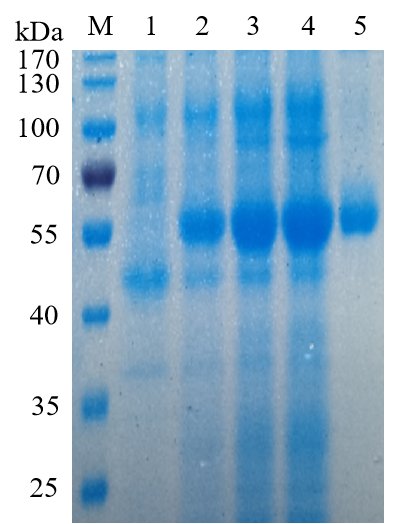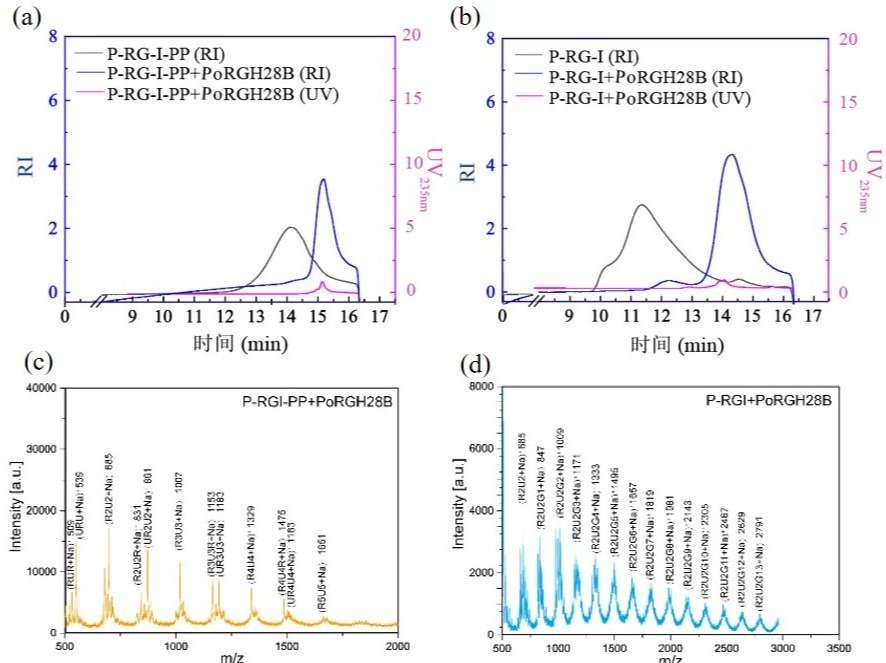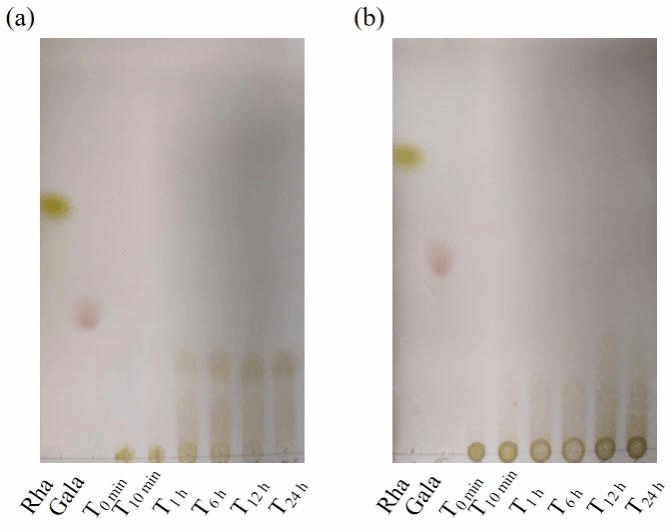PoRgh28B(Rhamnogalacturonan hydrolase)
PoRgh28B
En-Rgh0340
(EC 3.2.1.171) Rhamnogalacturonan hydrolase
CAZy Family: GH28
PROPERTIES
1. ELECTROPHORETIC PURITY
-Single band on SDS-gel electrophoresis (MW ~47 kDa)

Fig 1. Electrophoresis analysis of PoRgh28B. M, molecular weight marker (PageRuler Prestained Protein Ladder, Thermo Scientific); lane 1, culture lysate before methanol induction; lane 2, culture lysate after induction for 24 h; lane 3, culture lysate after induction for 48 h;lane 4, culture lysate after induction for 72 h;lane 5, PoRgh28B purified from Ni sepharose fast flow column.
2. SPECIFIC ACTIVITY
126.1 U/mg protein (on RG-I from Potato) at pH 4.0 and 37°C
One unit of RGH activity was defined as the amount of enzyme required to generate 1 μg of reducing sugar in 1 min.
3. RELATIVE RATES OF HYDROLYSIS OF SUBSTRATES
Table 1 Substrate specificity of PoRgh28B
Substrate |
Structural features |
Relative activity (%)a |
HG |
HG |
-- |
P-RG-I-PP |
RG-I backbone |
100±7.85 |
P-RG-I |
RG-I |
46.96±8.84 |
AT-RG-I |
RG-I |
74.89±6.93 |
PQ-RG-I |
RG-I |
10.51±1.98 |
PG-A |
RG-I |
6.73±2.97 |
PG-B |
RG-I |
13.53±4.03 |
PG-CP |
Galactan |
3.56±6.29 |
SA |
Arabinan+RG-I backbone |
15.26±1.91 |
a Activity toward P-RG-I-PP(potato) is taken as 100%
4. PHYSICOCHEMICAL PROPERTIES
pH Optima: 4.0
pH Stability: 4.0-6.0
Temperature Optima: 40°C
Temperature Stability: 30-50°C

Figure 2. Effect of temperature and pH on the activity and stability of recombinant PoRgh28B. (a) Optimum pH. Assays were carried out at 37°C for 10 min in buffers ranging in pH from 2.0 to 11.0. The activity at optimum pH was defifined as 100%. (b) pH stability. Assays were carried out after the incubation of the enzyme in buffers ranging from pH 2.0-11.0 at 4°C. (c) Optimum temperature. Activity was measured between 20°C and 90°C at pH 4.0 for 10 min. The activity at optimum temperature was defifined as 100%. (d) Thermostability. Assays were carried out in 20 mM HAc-NaAc buffer (pH 4.0) at 37°C for 10 min after the incubation of the enzyme at 30-70°C. The activity without heat treatment was defifined as 100%.

Figure 3. The mode of action of PoRgh28B. HPGPC analysis of the hydrolysis products of P-RG-I-PP(a) and P-RG-I(b) by PoRgh28B. MALDI-TOF-MS analysis the hydrolysis products of P-RG-I-PP(c) and P-RG-I(d) by PoRgh28B.

Figure 4. TLC analysis the hydrolysis products of AT-RG-I and P-RG-I by PoRgh28B.
5. STORAGE CONDITIONS
The enzyme should be stored at -20°C. For assay, this enzyme should be diluted in HAc-NaAc buffer (20 mM) pH 4.0. Swirl to mix the enzyme immediately prior to use.
6. REFERENCE
[1] 孟嘉仪. 草酸青霉中鼠李半乳糖醛酸酶的克隆表达及功能研究[D]. 东北师范大学, 2024.


